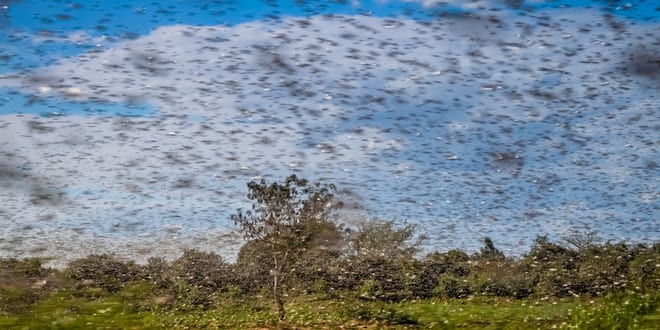In Chapter 10 of Exodus, Moshe and Aharon went to Pharoah to demand that Pharoah let the Israelites leave Egypt to worship God – or else a plague of swarming locusts will attack his country and eat all its greenery.
Locust plagues are a notorious, ancient phenomenon. Thanks to researchers at Tel Aviv University (TAU) we now know the complicated mechanism the induced solidary, harmless locusts to suddenly throng together and carpet Egypt, destroying the fields along the way.
The new study was based on a multidisciplinary collaboration of experts in fields as varied as insect behavior and physiology, microbiology, and computational models of evolution. The project was led by Prof. Amir Ayali and doctoral student Omer Lavy from the School of Zoology at TAU’s George Wise Faculty of Life Sciences.
Participants included Prof. Lilach Hadany, Ohad Lewin-Epstein and Yonatan Bendett from the School of Plant Sciences and Food Security and Prof. Uri Gophna from the Shmunis School of Biomedicine and Cancer Research, all of the Wise Faculty. They were joined by Dr. Eran Gefen from the University of Haifa-Oranim. The paper was published in Environmental Microbiology under the title “Microbiome-related aspects of locust density-dependent phase transition.”
“When a solitary locust joins a group, its gut microbiome (the bacterial composition in its gut) undergoes a profound change. A mathematical model demonstrates that swarming may be advantageous to the altered microbiome’s dominant bacterial species, which spreads by infecting large numbers of locusts.”
The bacteria, called Weissella cibaria, has been found in Korean kimchi — a probiotic, fermented food with several health benefits including the regulation of the immune system, promotion of weight loss, the fight against inflammation and even slowing the aging process. Kimchi can be produced with many different kinds of vegetables and even include fish or meat. W. cibaria are almost completely absent from the microbiome of solitary locusts, but they become dominant in the gregarious phase.
“Our findings do not prove unequivocally that these bacteria cause locusts to swarm and migrate,” they wrote, “but they do lead us to propose a new hypothesis – that the microbiome and specifically the Weissella (Firmicutes) bacteria play an important role in inducing the locusts’ aggregation behavior. We hope that this new understanding will drive the development of new means for combating locust outbreaks – still a major threat to countless people, animals, and plants all over the globe.”
“Locust swarms that decimate all crops in their path have been a major cause of famine from biblical times to the present,” added Ayali. “Over the last three years, large parts of Africa, India and Pakistan have been hard-hit by locust outbreaks, and climate change is expected to exacerbate the problem even further. Locust swarms form when individual locusts, usually solitary and harmless, aggregate and begin to migrate. However, the causes for this behavior remain largely unknown, and an effective solution is yet to be found. Following recent studies, indicating that microbiomes can influence their hosts’ social behavior, we hypothesized that locusts’ microbiomes may play a role in their aggregation behavior.”
To test their theory, the researchers examined the gut microbiomes of locusts raised in the lab and found a significant change when individuals reared in solitary conditions joined a large group of about 200 locusts.
“The most significant change was observed in Weissella, almost completely absent from the microbiome of solitary locusts, which became dominant soon after their hosts joined the group,” said Lavy.
The researchers then developed a mathematical model to analyze the conditions under which induction of locust aggregation produces significant evolutionary advantages for Weissella, allowing these bacteria to spread to numerous other hosts.
Based on these results, the researchers hypothesize that Weissella bacteria may play an important role in the locust aggregation behavior. In other words, the bacteria may in some way encourage their hosts to change their behavior and become more ‘sociable’.
The idea that the bacteria play an important role in inducing this behavior is a new hypothesis that has never been previously proposed, said Ayali. “We hope that this new understanding will drive the development of new means for combating locust outbreaks – still a major threat to countless people, animals, and plants all over the globe.”
The shortcode is missing a valid Donation Form ID attribute.




